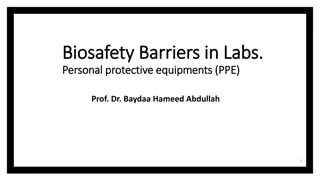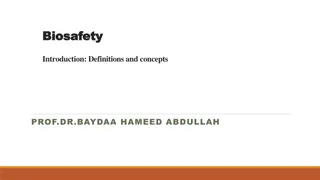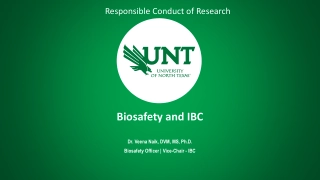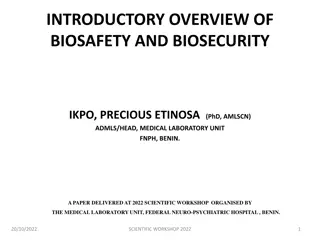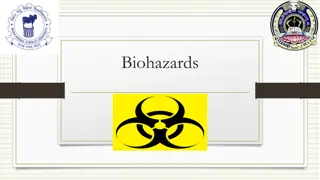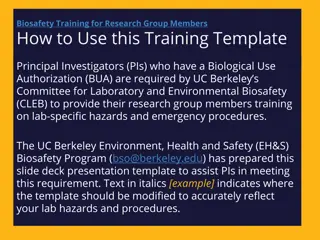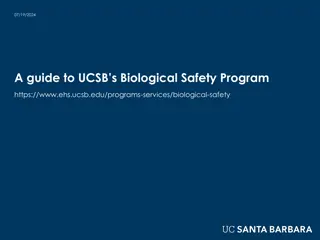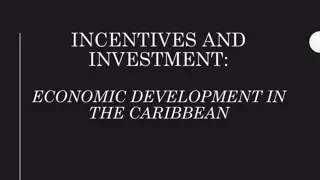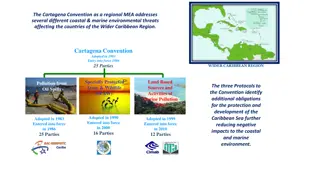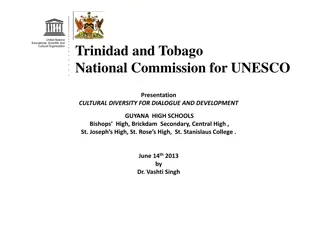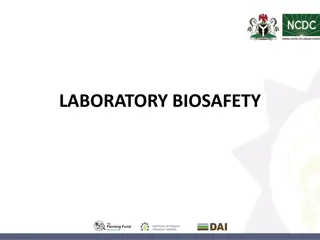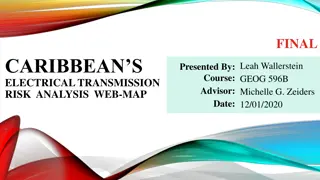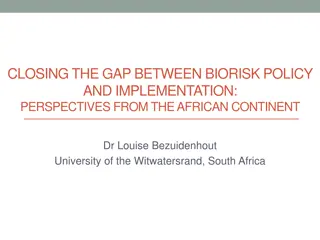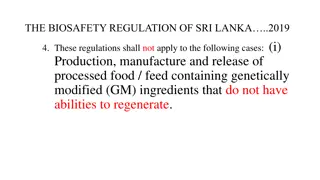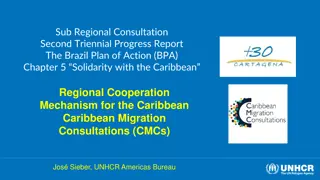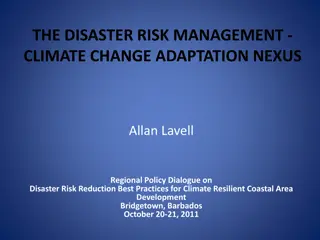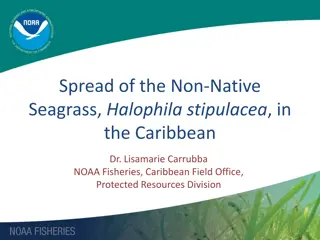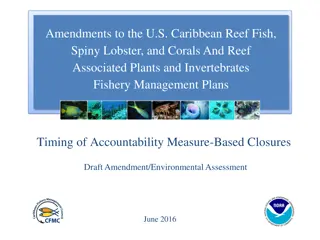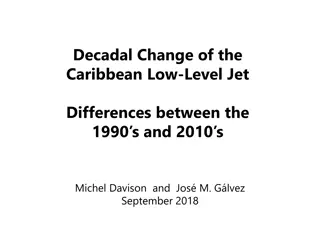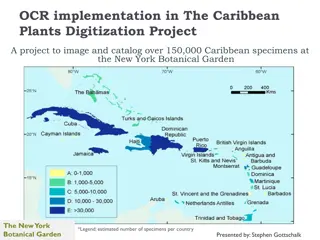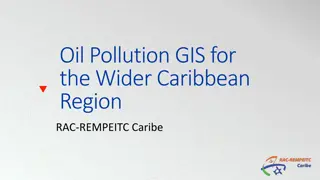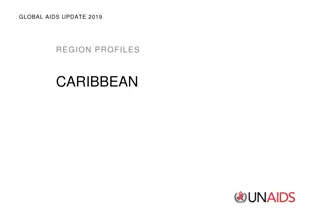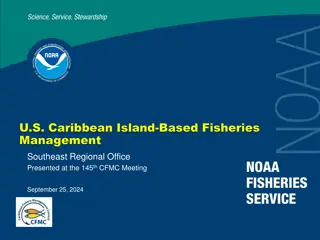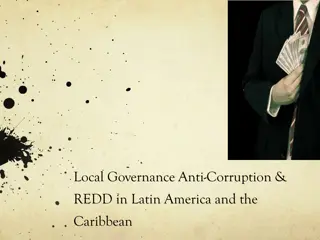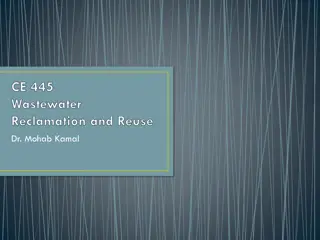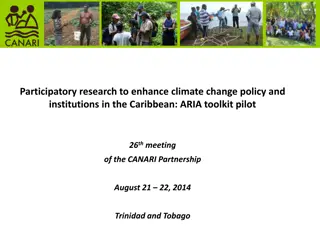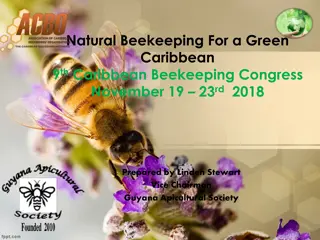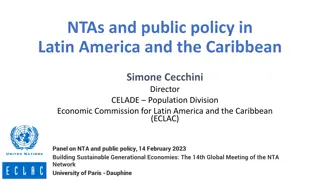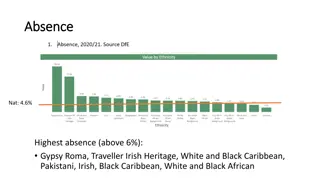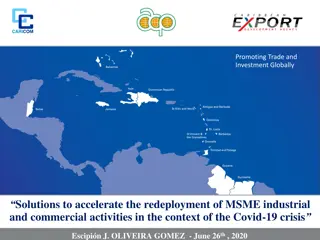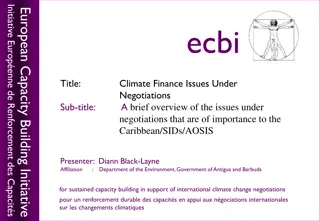Understanding Risk Assessment for Biosafety in the Caribbean Sub-Region
Risk assessment is a structured approach to evaluating the potential harm from activities involving genetically modified organisms (GMOs) in order to protect health and the environment. It involves identifying, characterizing, and evaluating risks to determine the level of concern and the need for mitigation measures. Definitions of key terms such as harm, risk, consequence, likelihood, and protection goals are provided, along with key questions that guide the risk assessment process.
Download Presentation

Please find below an Image/Link to download the presentation.
The content on the website is provided AS IS for your information and personal use only. It may not be sold, licensed, or shared on other websites without obtaining consent from the author. Download presentation by click this link. If you encounter any issues during the download, it is possible that the publisher has removed the file from their server.
E N D
Presentation Transcript
Regional Project for Implementing National Biosafety Frameworks in the Caribbean Sub-Region. NATIONAL BIOSAFETY TRAINNING MARCH, 2016 BIOSAFETY RISK ASSESSMENT ROLAND ROYER BUREAU OF STANDARDS
What is Risk Assessment? A structured, reasoned approach for considering the chance of harm from certain activities with a GMO, based on scientific/technical evidence Aims to identify, characterise and evaluate risks to the health and safety of people or to the environment from activities with GMOs (e.g. Protection Goals) Identifies risk by considering what could go wrong and how harm might occur Characterises risk by considering how serious the harm could be (consequences) and how likely that harm could occur within the context of the case Level of risk is evaluated by integrating consequences and likelihood, and the need for measures to reduce is considered where pertinent Initially considers a wide range of potential pathways whereby harm might occur. Those pathways that describe substantive risks are considered in more detail and the level of risk evaluated
Definitions Harm - Adverse outcome or impact to Protection Goal(s). May include change in morphology, physiology, growth, development, reproduction or life span of an organism/group of organisms that results in an impairment of functional capacity (e.g. capacity to compensate for additional stress) or an increase in susceptibility to other influences (e.g. disease). Many biological changes are not considered inherently adverse Risk - Potential for harm from an activity. Includes the effect of uncertainty on Protection Goals. The level of risk should be evaluated according to the degree of seriousness and chance of harm occurring Consequence - Harm to a Protection Goal(s) from an activity. An activity can lead to a range of consequences. Initial consequences can escalate through knock-on effects Likelihood - Chance. Is a general description of the probability, frequency or possibility of causal links in a postulated pathway to harm. Determines the chance that harm may occur, ranging from highly unlikely to highly likely Protection Goals e.g the health and safety of people and the environment
Key Questions of Risk Assessment What could go wrong? Initially a broad range of circumstances is considered, whereby the proposed GMO activities are postulated to give rise to harm to the Protection Goals. Each pathway to harm describes a plausible causal linkage between the GMO and harm How serious could the harm be? An identified risk is subjected to an assessment of the seriousness of potential harm via the particular pathway to harm How likely is the harm to occur? An identified harm is also assessed with regard to the chance of the occurrence of a series of individual steps in a pathway that may lead to harm. The assessment will derive the chance of harm from the overall series of individual steps What is the level of concern? The level of risk is evaluated as negligible, low, moderate or high by considering a combination of the seriousness of harm and the likelihood of it occurring. Risk evaluation determines whether or not mitigation measures to reduce risk are required
What could go wrong? - Postulating Pathways to Harm Many possible pathways can be formulated covering a wide range of circumstances where potential harm to Protection Goals can be credibly linked to exposure to the GMO or GM product, but only those risks that may be greater than negligible are considered in detail The relevance or importance of each postulated pathway will depend on the context e.g. the effects of a novel GM trait will need to be considered in the context of the whole organism The plausibility of the pathway will depend on a broad range of external factors e.g. availability of sexually compatible relatives, likely environmental conditions or the nature of nearby land use In addition, interactions between pathways may give rise to Synergistic (greater than sum), additive (increased) or antagonistic (decreased) effects
How serious could the harm be? - Degrees of Possible Harm The perception of harm can vary between people It can also change over time and differ according to other factors, e.g. variations in the vulnerability of individuals or type of land use: A cold medication may be considered harmful if it causes severe side-effects, however a cancer drug causing the same type of side-effects might not be considered harmful A plant producing large amounts of biomass in a pasture may be considered desirable whereas the same plant may be considered harmful (weedy) in a nature conservations area as it may displace a native species In addition, one harmful outcome can sometimes give rise to further downstream harms, e.g. increased harms from weeds, pests or pathogens can lead to loss of biodiversity
Undesirable Harms - Definitions No consensus exists, but proposed definitions of harm feature: damage to a resource (for example, a reduction in the conservation or sustainable use of biodiversity); an adverse change that is either significant or severe or that exceeds the natural range of variability; and is measurable (or predictable). Leads to three main questions when defining harm: What needs to be protected? What is meant by adverse ? and What is to be measured, and for how long, in order to predict the likelihood that harm will occur?
Degrees of Possible Harm The seriousness of harm is dependent on the scale at which impacts are considered. Harm to humans is usually considered significant at the level of an individual, whereas harm to the environment is usually considered significant at the level of species, communities or ecosystems Assessing the seriousness of harm may include: What is the magnitude of each potential adverse impact: does it cause a large change over baseline conditions? What is the spatial extent or scale of the potential adverse impact? What is the temporal (duration? frequency?) occurrence of the impact? Can the adverse impact be reversed and, if so, how long will this take? Is the exposed species rare or endangered?
Degrees of Possible Harm - Qualitative Generic consequence assessment criteria for the degree of harm to Protection Goals
How likely is the harm to occur? The likelihood assessment determines the chance that harm will occur, and is expressed as highly likely, likely, unlikely or highly unlikely If the chance of harm is close to zero, then the risk is considered minimal and needs no further analysis If several steps have only a small chance of occurring, then the overall pathway has an extremely limited chance of occurring due to the combination of several low probability steps Alternatively, one step may have almost no chance of occurring, resulting in a very low overall probability even if all the other steps have a reasonable chance of occurring
Testing the Pathway to Harm Identify key steps in pathway, and add available data where pertinent Determine if the existing data break the pathway If not, identify what additional data would allow satisfactory testing of the hypothesis Risk hypothesis: Cultivation of DT maize leads to loss of genetic diversity in landraces DT maize is planted in same area as the conventional maize - HIGHLY LIKELY Farmers prefer growing DT maize to conventional maize - INFORMATION ON FARMER PREFERENCES With time farmers will stop growing certain/all landraces - LIKELY Farmers do not store or multiply their landraces to maintain viability - UNLIKELY Loss of landraces and hence genetic diversity -HIGHLY UNLIKELY
What is Uncertainty? Uncertainty is integral to the process of risk analysis There are several types of uncertainty in risk analysis (first tier uncertainty analysis): Uncertainty about facts Knowledge - data gaps, errors, small sample size, use of surrogate data Variability - inherent fluctuations or differences over time, space or group, associated with diversity and heterogeneity Uncertainty about ideas Description - expression of ideas with symbols, language or models can be subject to vagueness, ambiguity, context dependence, etc. Perception - processing and interpreting risk is shaped by our mental processes and social/cultural circumstances, which vary between individuals and over time
Managing Uncertainty Some typical approaches to addressing uncertainty in risk analysis include: Establishing parameters for data quality Obtaining additional information Identifying and correcting errors Applying conservative estimates Using upper and lower bounds of estimates Seeking expert opinion or independent review Providing clear definitions of key words Prioritising by re-evaluation against objectives, scope and problem formulation Applying additional controls to manage risks Applying second tieruncertainty analysis e.g. building worst case scenarios or by using meta- analysis where results of several studies are combined
What is the level of concern? - Evaluation of levels of risk Risk is evaluated against the Protection Goals to determine the level of concern and, subsequently, the need for controls to mitigate or reduce risk. May also help determine whether the proposed GMO activity should be authorised, needs further assessment, or requires collection of additional information Factors used to determine which risks need treatment may include: The significance of difference between GMO and counterpart Level of risk Uncertainty associated with risk analysis Interactions between potential risks Risk evaluation combines the consequence and likelihood assessments, using a risk matrix, to determine the level of risk and whether risk treatment is required to reduce the level of risk. This includes consideration of uncertainty and its impact on decision-making


